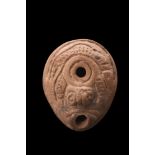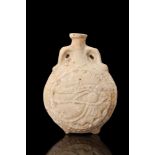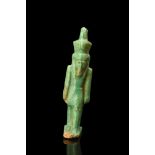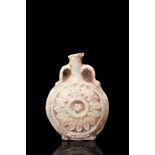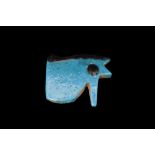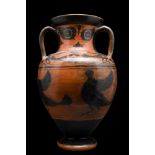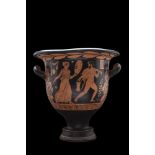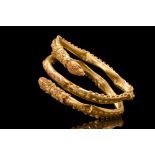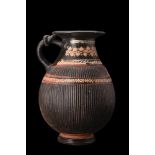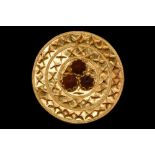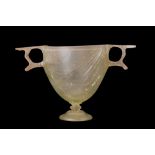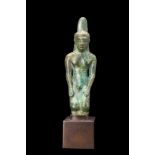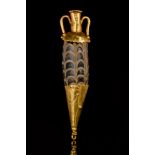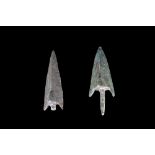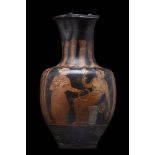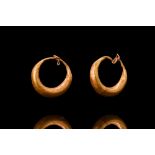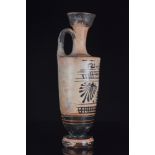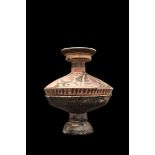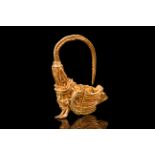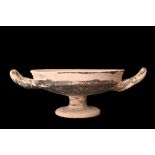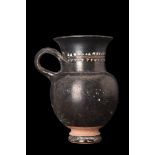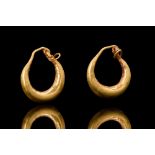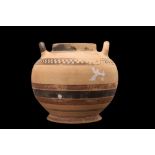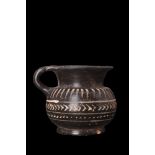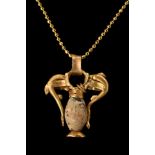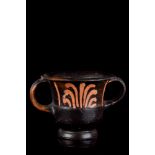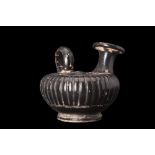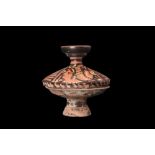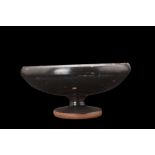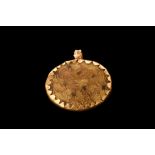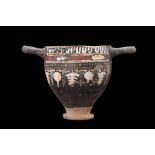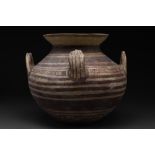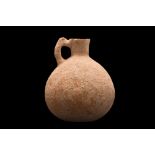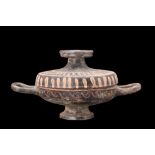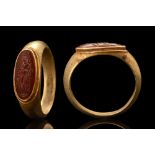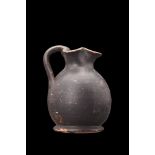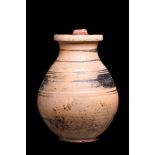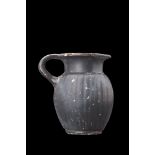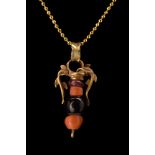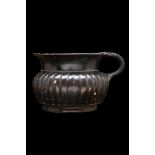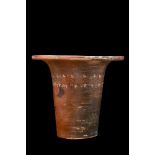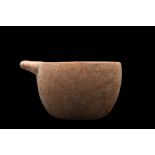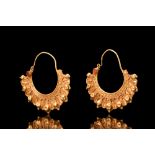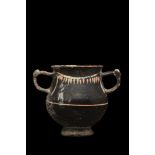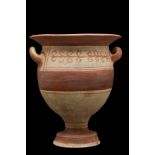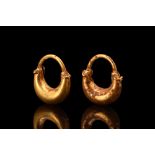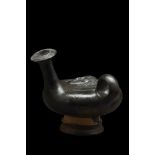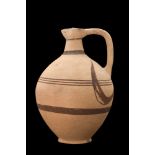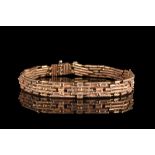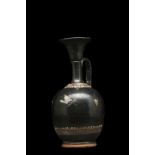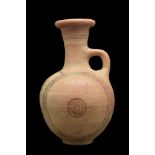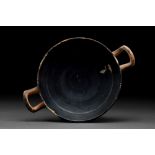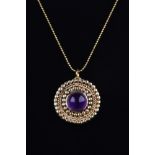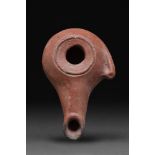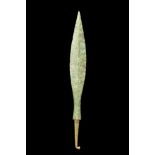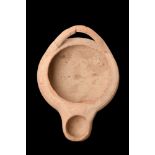Refine your search
Estimate
Category
- Jewellery (131)
- Greek, Roman, Egyptian & Other Antiquities (64)
- Coins (61)
- Ceramics (30)
- Glassware (23)
- Sculpture (20)
- Collectables (18)
- Arms, Armour & Militaria (14)
- Salvage & Architectural Antiques (11)
- Books & Periodicals (7)
- Metalware (6)
- Porcelain (5)
- Kitchenalia (4)
- Scientific Instruments (3)
- Vintage Fashion (3)
- Sporting Memorabilia & Equipment (2)
- Taxidermy & Natural History (2)
- Classic Cars, Motorcycles & Automobilia (1)
- Clocks (1)
- Furniture (1)
- Lighting (1)
- Oil, Acrylic paintings & Mixed Media (1)
- Tools (1)
- Watches & Watch accessories (1)
- List
- Grid
A subscription to the Price Guide is required to view results for auctions ten days or older. Click here for more information
Ca. 200-300 AD. A terracotta oil lamp of a teardrop shape, with a small spout and a central recess for filling oil. The main body of the lamp is f...
Ca. 660-525 BC. A faience New Year's flask of a lentoid body with twin arched handles flanking the trumpet-shaped spout. One side is decorated wit...
Third Intermediate Period to Late Period, ca. 1070-332 BC. A glazed composition amulet of Nefertum, the Egyptian god of health and perfume, and on...
Ca. 660-525 BC. A faience New Year's flask with lentoid body, adorned with twin arched handles on either side, further complemented by a trumpet-s...
Third Intermediate Period, ca. 1069-702 BC. A glazed composition wedjat amulet depicted with a black brow, and pupil creating a stark contrast wit...
Ca. 525-500 BC. A large Etruscan amphora by Micali painter with double sided panels of black and red sirens are beautifully rendered as well as lo...
Ca. 400-300 BC. A beautiful red-figure terracotta krater with a broad rim, bell-shaped body flanked by two lug handles, and a pedestalled ring foo...
HELLENISTIC GOLD SNAKE BRACELET
Ca. 300 BC (or later). A magnificent 21k gold bracelet formed of a coiled hollow gold rod with a flat interior and a slightly rounded exterior. Th...
Ca. 370-325 BC. A graceful pottery large mug or pitcher with a finely ribbed body segmented by a double meander chain band and a wave band, each p...
Ca. 350 BC. A black-glazed pottery hydria with a characteristic bulbous body with a short, splayed foot, a funnel-shaped neck decorated with a ban...
Ca. 300-100 BC. A stunning gold disc-shaped adornment, crafted with remarkable skill and precision. The ornament features a central motif comprisi...
Ca. 200 BC. An elegant glass skyphos consisting of a deep cup supported by a pedestal foot, with two opposing handles adorning its sides. The pale...
Ca. 640-430 BC. A bronze figure of nude kouros depicted kneeling on a flat block. His hands rest on his thighs, his head slightly down, with fine ...
Ca. 300-100 BC. A rare pendant in the shape of an amphoriskos - amphoriskoi (from Greek, "small amphorae") were small jars with two handles that w...
GREEK GILDED CHALCIDIAN HELMET
Ca. 500-300 BC. A helmet comprising of hammered gilt bronze. The domed crown with front with medial ridge, with contoured double curve above the b...
Ca. 700-500 BC. A pair of cast bronze arrowheads, each with a lentoid-sectioned blade that has a raised midrib, a tang, and are sharpened to a poi...
APULIAN RED-FIGURE OINOCHOE
Southern Italy, ca. 4th century BC. A trefoil spouted oinochoe beautifully decorated with the red-figure technique. The oinochoe features an ovoid...
Ca. 400 BC. A stunning pair of gold earrings. The elegant design of each hollow boat-shaped element tapers to a thin plain earwire, which is secur...
Ancient Greece, Athens, ca. 6th century BCE.. A wheel-thrown lekythos with straight walls that rise to a flat shoulder which tapers to a corseted ...
Ca. 340-325 BC. A ceramic lekanis of the red-figure lid with two female profile heads between palmettes and stylised volutes. The "Ladies of Fashi...
Ca. 350 BC. A breathtaking gold earring with its highly decorative shank, comprised of twisted and ribbed wires. At one end of the shank is a harp...
GREEK ATTIC POTTERY KYLIX
Ca. 500 BC. A terracotta kylix with a hemispherical bowl, short pedestal foot, and two equally spaced loop handles. Decorated in a characteristic ...
Ca. 300 BC. A beautiful wheel-thrown drinking vessel with a short concave foot with central fillet, a bulbous body, cylindrical neck, a wide, fla...
Ca. 370-325 BC. This olpe features a bulbous body that is characterised by vertical ribbing, which adds texture and visual interest to the vessel....
Ca. 400 BC. A matched pair of gold earrings, featuring a distinctive boat-shaped design that evoked the maritime spirit of the Hellenistic era. Ea...
Ca. 350-300 BC. A beautiful black glazed terracotta thistle mug featuring a pedestal foot, from which the globular body raises and opens into a fu...
MESSAPIAN POTTERY LEBES GAMIKOS
Ca. 400-300 BC. A terracotta lebes gamikos, a delicately formed "marriage vase" with an inverted bell-shaped body and its characteristic pair of h...
ANCIENT GREEK POTTERY OLPE
Ca. 350 BC. A black glaze olpe featuring a bulbous body that sits atop a low flared base, creating a sense of stability and proportion. The broad ...
Ca. 400 BC. A gold pendant comprising a central shaft threaded with a large bead secured at the bottom with a foot. Looped finial, serving as a su...
Apulia, Ca. 2nd half of the 4th Century BC. An attractive miniature kantharos, a deep, slightly waisted cup on a disc foot with two, opposing stra...
Ca. 360-320 BC. A ceramic black-glazed guttos with a discoid body, pedestal foot, loop handle, and trumpet-shaped spout; circumferential fluting a...
Ca. 340-325 BC. A terracotta red-figure lekanis consisting of a black-glazed footed dish with a flange to receive the lid that is elaborately deco...
Ca. 500-400 BC. An exquisite terracotta cup featuring a wide bowl with flared sides and an inward rim, which adds a sense of refinement and elegan...
Ca. 400-300 BC. An elegant pendant with an oval-shaped insert encased in a gold frame with a serrated edge and a suspension loop. The oval-shaped ...
Ca. 375-300 BC. This skyphos is a particularly nice and well-preserved example of a typical drinking cup from Southern Italy in the highly decorat...
Ca. 2nd millennium BC. A huge pottery vessel featuring a nearly spherical-shaped lower body with a slightly flattened base. From the top of the sp...
CYPRIOT-LEVANTINE TERRACOTTA JUG
Ca. 2nd millennium BC. A very fine terracotta jug with a handle and a short neck. It was used for storing and carrying food, water, and other liqu...
Ca. 350-300 BC. A pottery lekanis consisting of a shallow bowl, with its black glaze and red wave pattern, opposing loop handles, stem foot, and a...
Ca. 100-200 AD. A gold signet ring of a smooth, round band with bezel enclosing red hardstone intaglio engraved with a depiction of facing left, s...
Ca. 400 BC. A black-glazed pottery vessel with a globular rounded body swelling out from a low ring foot. The lip is pinched into a trefoil patter...
DAUNIAN POTTERY OLPE (JUG)
Ca. 600–500 BC. Daunia, Southern Italy.. A beautiful olpe featuring an elongated body, round mouth, and a high arching single handle. The body is ...
Ca. 340-325 BC. A blackware pottery olpe with a circular base, a globular-shaped body with ribbing features, a convex shoulder, a short neck, and ...
Ca. 400 BC. A gold pendant of central wired shaft threaded with five stone beads, secured at the bottom with a small hoop. To the top, a pair of s...
Ca. 350 BC. A black-glazed pottery mug with a globular, ribbed corpus swelling out from a low ring foot. The lip is finished with a flat, everted ...
GREEK POTTERY KALATHOS
Ca. 300 BC. A terracotta kalathos with its characteristic and distinctive inverted bell-shaped body, decorated with added vegetal tendrils adornin...
Ca. 2nd millennium BC. A pottery vessel featuring a deep basin, gently tapering to a flat base. From the side one loop handle protrudes. Size: L:1...
Ca. 300-100 BC. A pair of beautiful gold earrings, each comprising an oval-shaped hoop with a hooked attachment and a semi-circular filigree desig...
Ca. 330-300 BC. A stunning cup boasting a bulbous body that sits elegantly on a low stepped base, culminating in a gently tapered neck that flows ...
Ca. 350-300 BC. A finely modelled Daunian pottery krater with a large, rounded body, a broad funnel rim, and twin upraised handles, all upon a fla...
Ca. 300-200 BC. A beautiful pair of boat-shaped hollow body earrings. Each tapers to a thin plain wire with a fastening mechanism on one end.Size:...
Ca. 400-300 BC. A blackware guttus with a rounded, convex-shaped body, a single loop handle, a high spout with a funnel mouth and an everted rim a...
Cyprus, ca. 600-475 BC. Pottery handled jug having a tapered bulbous body, trefoil lip, and strap handle. Cream slip ground with a painted dark br...
INTACT HELLENISTIC GOLD BRACELET
Ca. 300 BC. A stunning bracelet composed of gold coiled tubes woven together with gold wire and secured with a pin. The bracelet is further embell...
GREEK GNATHIAN WARE LEKYTHOS
Ca. 400-300 BC.A fine wheel-thrown pottery lekythos with a low ring foot, a tall ovoid body, a discoid rim with a funnel mouth, and an applied arc...
CYPRIOT POTTERY ARYBALLOS
Cypro-Archaic, ca. 750-600 BC. A beautiful wheel-thrown redware pottery aryballos with a squat foot, a spherical body, a cylindrical neck, a circu...
GREEK ATTIC BLACKWARE KYLIX
Ca. 400 BC. A stemless terracotta Greek kylix (drinking cup), covered in a black gloss. The large, shallow body rests on a low foot that concaves,...
Ca. 323-31 BC. A finely rendered gold disc-shaped pendant, hammered from thin gold, embellished with three bands of alternating beaded and ropewor...
HELLENISTIC TERRACOTTA OIL LAMP
Ca. 1st century BC - 1st century AD. A terracotta oil lamp with a round upper body with inward-sloping discus and a filling hole. The long nozzle ...
ANCIENT BRONZE SPEAR
Cyprus, ca. 1st millennium BC. A magnificent cast bronze spearhead featuring an ovate blade, which is accentuated by a raised midrib that runs dow...
Ca. 550 BC. A terracotta oil lamp Broneer I type with its characteristic round, shallow body, which is open with inward curving walls. The lamp al...

